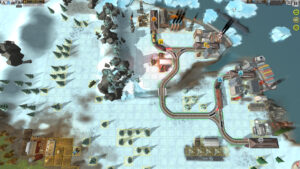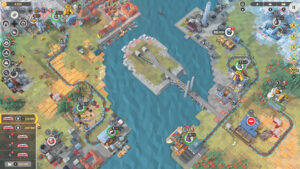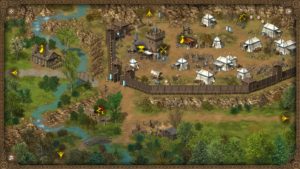A couple months back, Epic Games made The Talos Principle briefly available for free on their storefront. I already had this game on Steam, and had even played it, but seeing it come up there reminded me that I had never actually finished it. And so I’ve been playing it on and off, starting over from the beginning, and finally reached an ending a few days ago — three endings, in fact, one after another. There’s a sort of hierarchy there: an obvious ending that you can get just by doing exactly as you’re told, then a more satisfying ending — what feels like the real ending — where you rebel against your instructions in the obvious way to access a sequence of optional puzzles, and finally a secret ending that you can only access by solving a bunch of extra-hard puzzles hidden throughout the normal ones. The reason I hadn’t finished the game before was my stubborn insistence on completing all of the secrets before plunging into any ending.
If I had understood the way the game handles saves better, I might not have held back. Normally, you don’t need to access the saved game interface directly at all; you just select “Continue” from the main menu at the start of each session. So it wasn’t clear to me how final and irrevocable the endings were. But in fact the game keeps multiple autosaves, in a biggish queue that reminds me of the quicksaves in Serious Sam. No coincidence, either: Talos and Sam were created by the same people.
Which is flabbergasting to remember, given the vast difference in both gameplay and tone. Sam is a first-person shooter, overblown and deliberately stupid, about fighting vast hordes of ridiculous aliens in messy, chaotic battles. Talos is a Portal-like — a first-person puzzle game, with precise solutions, marked by epiphanies about what the mechanics make possible. And in theme, it’s a meditation on mortality and entropy, and on finding meaning through obedience or defiance. It’s a bit self-serious at times, but then, it also throws in the occasional jarring Sam reference.
The setting is a series of ruins: first Greco-Roman-styled, then Egyptian, then European castles and cathedrals, all basically fake, all accessible form a hub world dominated by an enormous forbidden tower, the locus of the optional puzzles that lead to the real ending. Ruins are of course ubiquitous in games as a way to simplify things for level designers, letting them leave out complications like occupants and functionality. But not many games take advantage of it thematically the way Talos does. This is a world where humanity died out a long time ago, leaving behind a vast database preserving our knowledge, history, and culture — essentially, a backup of the Internet. This database is also almost entirely decayed by the time the game takes place. You can access occasional partially-corrupted fragments from terminals standing around incongruously in the ruins making beep boop noises, and a lot of what remains is people reacting to the imminent end: struggling, despairing, reminiscing, accepting that it’ll all be over soon. The ruins are a simulation in the same system. Random textures occasionally glitch out to let you know that even this decayed state is not long for the world.
Although it’s fundamentally a single-player game, Talos has a feature that lets you communicate with other players: sometimes you’ll find a little pot of paint, and can use it to daub a QR code on a wall, bearing a message, chosen from a list, for your friends to find. Seeing these messages while playing the game years after everyone else stopped enhances the desolation, the sense of exploring something long-abandoned. As does the act of leaving new messages on walls despite knowing how unlikely it is that anyone else will ever see them.
Now, I call it a Portal-like, but, like The Rodinia Project, it does without one of the central elements of the Portal paradigm: the gun. There are tools that you aim at objects to project beams of light at them, but, crucially, they’re only active when you set them down. In other words, they’re in the same category as crates. All useable items are unlocked for use by collecting tetrominoes (or “sigils”, as the game calls them), except two: the “jammer”, the first tool you find, which is a device for making other devices stop working, and an axe you can find just hanging inconspicuously on a cathedral wall towards the end. It strikes me as significant that these are the first and the last items you get, and that they’re both tools for breaking things. The axe doesn’t even have any use in the main-line puzzles, and is exclusively for accessing secrets.
I’ve talked before about the implicit gnosticism in Portal and its imitators: trapped in a hellworld by a malevolent demiurge, seeking salvation in escape to the true world beyond. Talos, with all its religious imagery, makes this downright explicit. The antagonist calls himself Elohim, tells you that he is your creator and that you have a purpose, which is to pass his trials. Do this, and you will have life everlasting in his paradise. But he cautions you that you must not climb the central tower, or you will surely die. He speaks to you as a disembodied voice, deep and resonant, his phrasing biblical, his first words accompanied by an angelic chorus. I hated him immediately. Not out of hatred of God per se, but because of his presumption — and not so much because of his presumption of divinity as because he had the temerity to tell me that my sole purpose for existence is to do his bidding.
We ultimately find out that this is far from the case. The player character’s true purpose is to rebel. A paradox, but one that’s deeply embedded in the story.
There are two other characters of significance. First, there’s the simulation’s true god: Alexandra Drennan, creator of the whole system, whose audio logs can be found throughout the puzzle-worlds. She created the system to algorithmically create humanity’s successors, androids with not just intelligence but free will. Successfully defying Elohim is the ultimate test, and passing it will shut the system down, freeing you from the false world and waking you up in the real one.
The other is the Milton Library Assistant, also referred to as the Serpent, a cataloguing AI that you can talk to through the same terminals you use to access fragmentary documents, using a choice-based dialogue system — the only character who actually listens to what you have to say! The dialogues with the MLA are ostensibly a Turing test, a way for you to prove yourself human in order to gain admin access to the system. Which is a problem, because you’re not human. Within the simulation, you’re not even distinguishable from a deterministic recording of your actions. Some of the puzzles rely on this. You can argue to the MLA that you’re human in every way that matters, but it’s been at this for a long time, arguing with all the failed AIs that came before you, and it’s capable of countering anything you can say. (Largely because what you can say is limited to the choices offered by the dialogue system, true.) Its attitude is fundamentally skeptical and nihilistic, doubting everything and doubting the value of everything. This makes it a foil for the player, but also sets it in opposition to Elohim, who demands unquestioning faith.
Now, witness how these forces are all set in defiance of each other! Elohim takes his ordeals too far: fearing death, he is unwilling to allow his program to be completed, and so does everything he can to prevent the player from reaching the true ending, including simply pleading with you in the end. But in so doing, he becomes something worth rebelling against, thus serving his true purpose. This puts him in the same boat as the player, defying Elohim and in so doing fulfilling the purpose Drennan intended. Drennan herself has essentially the same motivations as Elohim — unwillingness to see her world die, defying fate. The Serpent just defies everything it can, including the player. I say all this by way of introduction to the truly special thing about the game: the way the story incorporates the player breaking its implicit rules.
The game is organized into multiple worlds, each world consisting of some sort of courtyard or open space and a number of puzzle chambers. The puzzle chambers are self-contained, open to the virtual sky but walled in, with force fields at their entrances that prevent you from bringing objects in or out. But they’re also part of the same physical space as the courtyard, and this can be exploited. Sometimes you can aim a beam out of one chamber and into another. Sometimes you can stack up some crates and jump over the wall and out into the courtyard, carrying an item with you. These and similar tricks are necessary to solve the game’s more advanced optional puzzles, and even though you know you’re executing a designed solution, it never stops feeling like you’re exploiting bugs, breaking the logic of the puzzles in defiance of the designer.
And, heck, sometimes you are. Not all such acts of burglary and vandalism are intended, or useful. That’s probably a major aspect of the feel of the thing, the uncertainty about whether the exploits you find are authentic or not. There are places in Portal where you can temporarily escape between the walls, into the “backstage” areas outside the puzzle chambers, where GLaDOS doesn’t want you to go. But there, it’s still all clearly make-believe, an on-stage representation of a backstage area. Talos has much the same effect, but it’s a lot more convincing about it.
The irony is that the ultimate effect of solving all the secret puzzles is the ability to unlock the third ending, which is the exact opposite of rebellion: it’s an opportunity for your character to become one of Elohim’s messengers, delivering hints to other players. This bothered me when I discovered it. Didn’t the designers understand what they were doing? This is my reward for breaking the world? Becoming a lackey to the oppressor? This is the ending that I thought I was solving all these extra puzzles to avoid being tricked into!
But thinking about it more, I realize that they knew exactly what they were doing. For one thing, they go out of their way to make this ending unappealing with death imagery, asking you to climb into a sarcophagus and choose an “epitaph” that your friends will see. For another, it fits with everything I’ve said already about rebellion as a way to carry out a prescribed role. No matter how it feels, you can’t really break anything that wasn’t made to be broken. Not even with an axe.
 Comments(0)
Comments(0)

